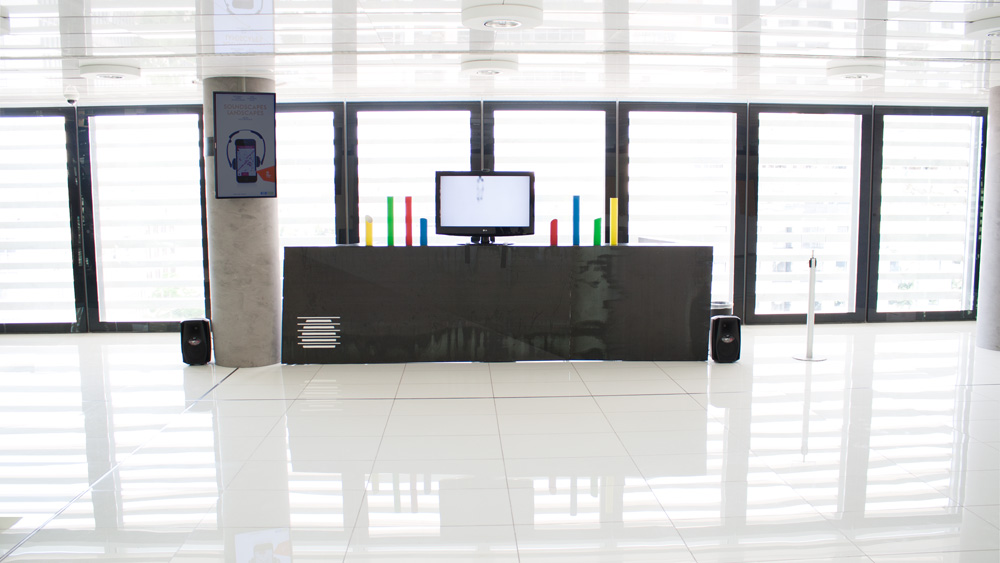-
yianK
posted in output~ • read moreThe patch is not dynamic, it is just 600 osc~, but the sound is because the amplitudes of each oscillator is calculated based on the position of the viewer.
And yes, it can be done with any image, in fact I will create more Ichographs with different paintings. BTW here is the first version of Ichographs http://kranidiotis.gr/ichographs/, a more 2D approach of the same principle. -
yianK
posted in output~ • read moreHello,
I would like to show my latest work, Ichographs MdelP (http://bit.ly/1QEFsJR), a sound and picture artwork that explores the relationships between colors and frequencies. The visual part was created with OpenFramework and the audio part in Pure data. Here is the video:
You can read more in the projects page: http://bit.ly/1QEFsJR
Thank you.
-
yianK
posted in news • read moreHello,
I would like to post my latest installation "Ichographs" which was done using C++ cinder lib and Pure Data. I used cinder lib to analyze the images, extract and calculate the audio frequencies (based on the colors of the image). These frequencies were sent to Pure Data via OSC. Every color is a sonic frequency. In Pure Data 600 cos oscillators were changing amplitude according to the corresponding color density. The audio part of the video is done 100% in Pure Data.
Note: This video has very low frequencies that are essential. Please use an audio system that can reproduce low-pitched audio frequencies. Built-in laptop speakers and basic desktop speakers are not recommended.
You can read more here: http://kranidiotis.gr/ichographs/
This forum was a great help during the creation of this project and the least I can do is to thank you all!
Yiannis
-
yianK
posted in news • read moreHello,
I would like to post my latest installation Colour Tubes which was done using Pure Data.
“Colour Tubes” is an interactive installation that allows us to combine colours, in the form of tubes and cylinders, and create sounds and music. The visitor is invited to connect any coloured tube with any coloured cylinder and move it in front of the screen. When different colours are combined, sound, music and visuals are generated depending on various parameters like the colour combination, the position or the speed of the bicolor tube-cylinder.
You can watch a demo video here:
I used OpenCV for the color tracking and OSC for communicating with Pure Data which generates the audio in realtime.
The installation was presented at Onasis Cultural Center during the International Computer Music Association and Sound & Music Computing 2014 Joint Conference at Athens, Greece. Here is a photo of the final installation.

You can read more here: http://kranidiotis.gr/colour-tubes-an-interactive-installation/
This forum was a great help during the creation of this project and the least I can do is to thank you all!
Yiannis
-
yianK
posted in technical issues • read moreHi,
I would like to know if there is already a way to generate quadratically interpolated noise similar to SC LFNoise2(http://doc.sccode.org/Classes/LFNoise2.html)
Thank you.
Yiannis
-
yianK
posted in technical issues • read moreThanks, this is very close to the sound of the real interpolated noise.
In the meantime I manage to create a patch that generates Cosine Interpolated Noise (because the calculations are simpler and the results quite similar).
I have attached the patch for reviewing.
A last question is how can I get the the noise data in numbers and not in signal. I tried to use unpack instead of unpack~ but it didn't worked.
-
yianK
posted in technical issues • read moreThe problem I have is that I need to make the calculations and play the audio data in the sample rate of the pd but this can not be done using [metro]. As I read in a previous post [metro] minimum interval is 1 millisecond.
Is there an alternative way to achieve a fastest metro (at 1/44.1)?
-
yianK
posted in technical issues • read moreThat's exactly what I am trying to do. To write a patch that will do the interpolation without the tabread4~
I'll let you know if I succeed!
-
yianK
posted in technical issues • read moreThanks! Actually it sounds very close to the SC's LFNoise2.
I will try to create a patch without the prewritten table and I will post it here for comments.
-
yianK
posted in technical issues • read moreAfter searching further about the LFNoise2 ugen I found sc4pd: SuperCollider for PureData, a port of some SuperCollider UGens to PD objects (https://github.com/pd-l2ork/pd/tree/master/externals/tb/sc4pd).
I tried to compile for windows (I managed to compile flext that was required) but I had no luck.
I wonder if anyone know if the compiled binaries of sc4pd are available for download or if anyone could have better luck on compile sc4pd.
